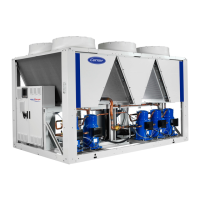
Do you have a question about the Carrier Aquasnap 30RQ 100R and is the answer not in the manual?
| Model | 30RQ 100R |
|---|---|
| Category | Chiller |
| Cooling Capacity | 100 kW |
| Compressor Type | Scroll |
| Refrigerant | R-410A |
| Power Supply | 400V / 3Ph / 50Hz |
| Noise Level | 65 dB(A) at 10m |
Recommendations for outdoor installation, ensuring adequate space, level surface, and protection from environmental factors.
Details physical characteristics such as sound levels, dimensions, weight, and component specifications for the unit range.
Provides essential electrical data, including voltage, current draw, power input, and short-circuit withstand capabilities.
Details requirements for the power supply, including voltage, phase imbalance, and connection specifications.
Explains how to calculate and assess voltage phase imbalance, with permissible limits and potential consequences.
Describes the location and function of the main power connection and disconnect switch for the unit.
Provides guidelines for selecting appropriate cable sizes based on current, voltage drop, and installation conditions.
Describes hydraulic circuit diagrams and connection types, emphasizing compatibility with closed loops.
Explains how to control flow rate using pressure differential with variable-speed pumps in hydraulic modules.
Describes flow rate control based on temperature difference for variable-speed pumps in hydraulic modules.
Comprehensive checklist of pre-start-up inspections for the unit, system, and electrical connections.
Guidelines and precautions for the unit commissioning process, emphasizing safety and proper operation.
Key checks for compressors, hydraulics, and refrigerant charge to ensure correct initial operation.
Basic maintenance tasks for users, including visual inspections, cleaning of air-cooled exchangers, and leak checks.
More advanced maintenance requiring specific expertise in electrical, hydraulic, and mechanical systems.
Specialized maintenance tasks requiring manufacturer-approved personnel, such as component replacement and refrigerant handling.
Section to record job details, contractor information, and personnel involved in the unit start-up process.
Fields for recording model and serial numbers for the main unit, compressors, and air handling equipment.
Checklist to verify unit installation, power supply, wiring, protection, and general condition before start-up.
Checks related to air handling units, including valve status, piping connections, air venting, and pump operation.
Steps for unit start-up, including pump connection, oil level check, leak testing, and voltage imbalance verification.
Procedure to verify water loop volume, corrosion inhibitor, frost protection, and piping configuration.
Method to measure and adjust evaporator pressure drop to determine the correct system flow rate.
Instructions to perform the QUICK TEST function, check user menu configuration, and start the chiller.
Guidance on recording key operating temperatures and pressures after the machine has stabilized.












